材料科学基础第八章
- 格式:docx
- 大小:12.90 KB
- 文档页数:4
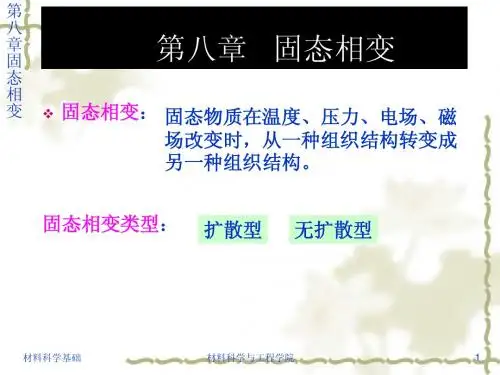
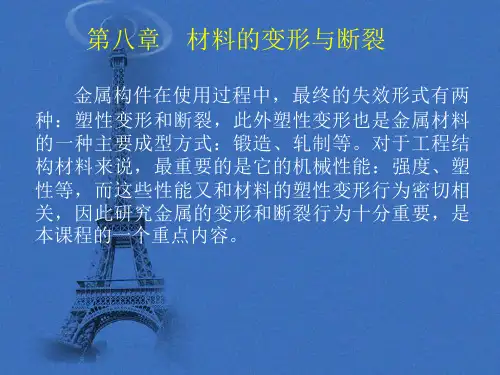
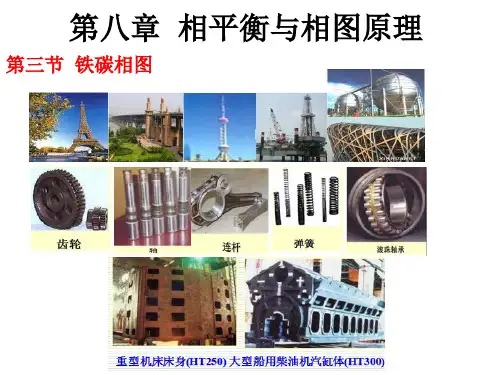

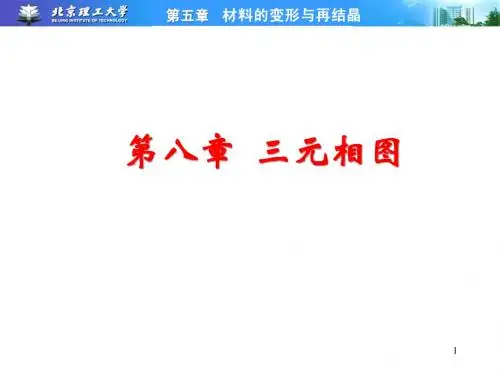
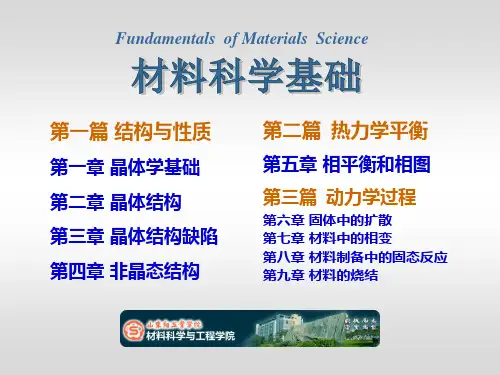

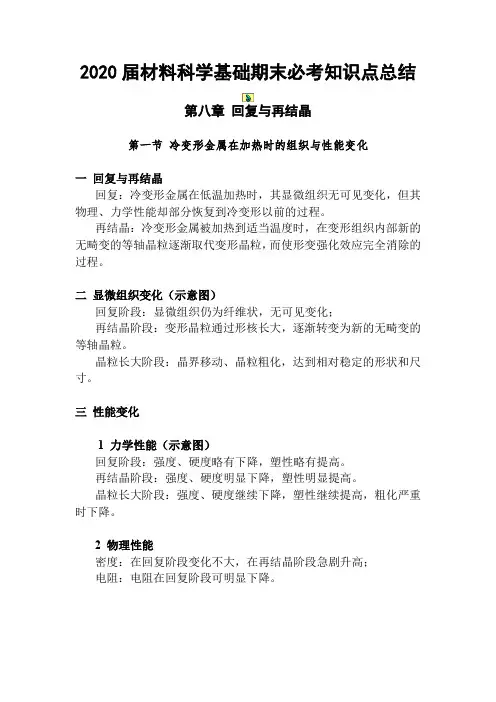
2020届材料科学基础期末必考知识点总结第八章回复与再结晶第一节冷变形金属在加热时的组织与性能变化一回复与再结晶回复:冷变形金属在低温加热时,其显微组织无可见变化,但其物理、力学性能却部分恢复到冷变形以前的过程。
再结晶:冷变形金属被加热到适当温度时,在变形组织内部新的无畸变的等轴晶粒逐渐取代变形晶粒,而使形变强化效应完全消除的过程。
二显微组织变化(示意图)回复阶段:显微组织仍为纤维状,无可见变化;再结晶阶段:变形晶粒通过形核长大,逐渐转变为新的无畸变的等轴晶粒。
晶粒长大阶段:晶界移动、晶粒粗化,达到相对稳定的形状和尺寸。
三性能变化1 力学性能(示意图)回复阶段:强度、硬度略有下降,塑性略有提高。
再结晶阶段:强度、硬度明显下降,塑性明显提高。
晶粒长大阶段:强度、硬度继续下降,塑性继续提高,粗化严重时下降。
2 物理性能密度:在回复阶段变化不大,在再结晶阶段急剧升高;电阻:电阻在回复阶段可明显下降。
四储存能变化(示意图)1 储存能:存在于冷变形金属内部的一小部分(~10%)变形功。
弹性应变能(3~12%)2 存在形式位错(80~90%)点缺陷是回复与再结晶的驱动力3储存能的释放:原子活动能力提高,迁移至平衡位置,储存能得以释放。
五内应力变化回复阶段:大部分或全部消除第一类内应力,部分消除第二、三类内应力;再结晶阶段:内应力可完全消除。
第二节回复一回复动力学(示意图)1 加工硬化残留率与退火温度和时间的关系ln(x0/x)=c0t exp(-Q/RT)x0 –原始加工硬化残留率;x-退火时加工硬化残留率;c0-比例常数;t-加热时间;T-加热温度。
2 动力学曲线特点(1)没有孕育期;(2)开始变化快,随后变慢;(3)长时间处理后,性能趋于一平衡值。
二回复机理移至晶界、位错处1 低温回复:点缺陷运动空位+间隙原子缺陷密度降低(0.1~0.2Tm)空位聚集(空位群、对)异号位错相遇而抵销2 中温回复:位错滑移位错缠结重新排列位错密度降低(0.2~0.3Tm)亚晶粒长大3 高温回复:位错攀移(+滑移)位错垂直排列(亚晶界)多边化(亚(0.3~0.5Tm)晶粒)弹性畸变能降低。

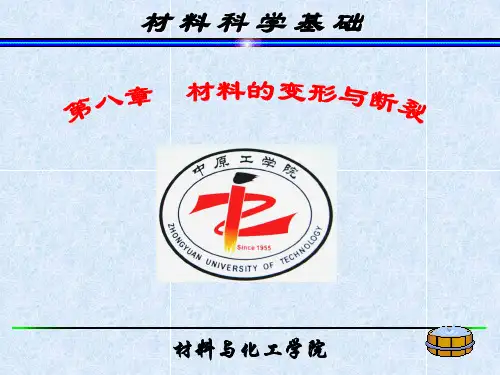
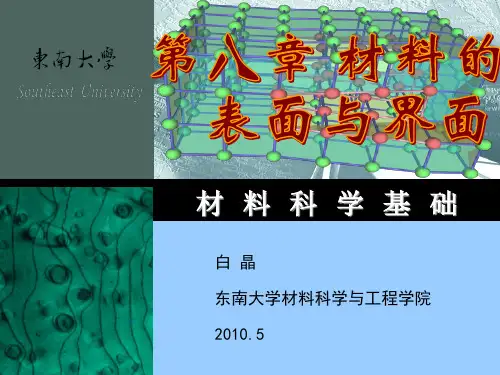
北京科技大学材料科学与工程专业814 材料科学基础主讲人:薛春阳第八章三元相图8.1三元相图基础三元相图的基本特点:完整的三元相图是三维立体模型;三元系中可发生四相平衡转变,四相平衡区是恒温水平面;三相平衡转变是变温过程,在相图上三相平衡区占有一定空间,不再是二元相图中的水平线。
8.1.1 成分表示法表示三元系成分的点位于两个坐标轴所限定的三角形内,这个三角形称为成分三角形或浓度三角形。
常用的成分三角形是等边三角形,有时也用直角三角形或等腰三角形。
1. 等边成分三角形B——浓度三角形等边三角型B%C%+顺时针坐标CA← A%1)确定O点的成分Ba)过O作A角对边的平行线b)求平行线与A坐标的截距得组元A的含量B%C%c)同理求组元B、C的含量OA← A%C2)等边成分三角形中的特殊线 7ABC90 80 70 60 50 40 30 20 101020 30 4050 60 708090 10 2030 40 50 60 70 8090← A%B% C%II 点:20%A- 50%B- 30%CIII 点:20%A- 20%B- 60%CIV 点:40%A- 0%B- 60%C IIIIIIVa)与某一边平行的直线凡成分点位于与等边三角形某一边相平行的直线上的各三元相,所含的与此线对应顶角代表的组元的质量分数相等。
凡成分点位于通过三角形某一顶角的直线上的所有三元系,所含此线两旁另两顶点所代表的两组元的质量分数比值相等。
b ) 过某一顶点作直线常数=====22221111''%%Bc Ca Bc Ba Bc Ba Bc Ca C A练习1. 确定合金I、II、III、IV的成分I 点:A%=60%B%=30%C%=10%II点:A%=20% B%=50% C%=30%III 点:A%=20% B%=20% C%=60%IV 点:A%=40% B%=0% C%=60%2. 标出75%A+10%B+15%C的合金3. 标出50%A+20%B+30%C的合金4. 绘出A =40%的合金5. 绘出C =30%的合金6. 绘出C / B =1/3的合金 %75%2531==B C 7. 绘出A / C =1/4的合金2.其它成分三角形1)等腰成分三角形当三元系中某一组元含量较少,而另两个组元含量较多时,合金成分点将靠近等边三角形的某一边。
2020届材料科学基础期末必考知识点总结豆第八章回复与再结晶第一节冷变形金属在加热时的组织与性能变化一回复与再结晶回复:冷变形金属在低温加热时,具显微组织无可见变化,但其物理、力学性能却部分恢复到冷变形以前的过程。
再结晶:冷变形金属被加热到适当温度时,在变形组织内部新的无畸变的等轴晶粒逐渐取代变形晶粒,而使形变强化效应完全消除的过程。
二显微组织变化(示意图)回复阶段:显微组织仍为纤维状,无可见变化;再结晶阶段:变形晶粒通过形核长大,逐渐转变为新的无畸变的等轴晶粒。
晶粒长大阶段:晶界移动、晶粒粗化,达到相对稳定的形状和尺三性能变化1力学性能(示意图)回复阶段:强度、硬度略有下降,塑性略有提高。
再结晶阶段:强度、硬度明显下降,塑性明显提高。
晶粒长大阶段:强度、硬度继续下降,塑性继续提高,粗化严重时下降。
2物理性能密度:在回复阶段变化不大,在再结晶阶段急剧升高;电阻:电阻在回复阶段可明显下降。
四储存能变化(示意图)1储存能:存在于冷变形金属内部的一小部分(〜10%)变形功。
「弹性应变能(3〜12%)2存在形式J位错(80〜90%) 1I点缺陷j 是回复与再结晶的驱动力3储存能的释放:原子活动能力提高,迁移至平衡位置,储存能得以释放。
五内应力变化回复阶段:大部分或全部消除第一类内应力,部分消除第二、三类内应力;再结晶阶段:内应力可完全消除。
第二节回复一回复动力学(示意图)1加工硬化残留率与退火温度和时间的关系ln(x o/x)=C o texp(-Q/RT)x o原始加工硬化残留率;X—退火时加工硬化残留率;C0一比例常数;t—加热时间;T—加热温度。
2动力学曲线特点(1)没有孕育期;(2)开始变化快,随后变慢;(3)长时间处理后,性能趋于一平衡值。
3高温回复:位错攀移(+滑移)f 位错垂直排列(亚晶界)+多边化(亚(0.3~0.5Tm )晶粒)一►弹性畸变能降低。
三回复退火的应用去应力退火:降低应力(保持加工硬化效果),防止工件变形、开 裂,提高耐蚀性。
第八章变形和强化机制一、学习目的材料在加工和服役过程中不可避免产生变形。
研究材料变形的基本原理既是预防材料服役中产生变形、断裂等失效的需要,也是设计材料塑性变形加工工艺的需要。
本章的学习目的就是通过了解晶体材料的变形过程和影响因素,掌握材料变形和强化机制。
增加材料塑性变形抗力的方法叫材料强化,由于晶体材料的塑性变形主要由晶格位错运动实现,因此材料的强化机制本质是阻碍位错运动。
细化晶粒产生更多的晶界以阻碍晶间位错运动;固溶合金化或引入强化相也可有效地阻碍晶格位错的运动;材料在塑性变形过程中会产生位错,因而使随后的位错运动受到抑制,导致材料强化(即加工硬化或形变强化),这些都是晶体材料有效的强化机制。
用晶体材料强化的思路研究高分子材料的弹性变形和塑性变形过程,探讨塑料、橡胶等高分子材料的强韧化机制也是本章的教学目的之一。
二、本章的主要内容1.从原子的角度描述刃型位错和螺型位错的运动。
2.施加切应力会使刃型位错和螺型位错运动,描述塑性变形是怎样由位错运动产生的。
3.定义滑移系,并举例说明。
4.描述多晶金属材料发生塑性变形时,它的晶粒结构是如何变化的。
5.说明晶界是如何阻碍位错运动的,并解释一个有着小晶粒的金属为什么比有着大晶粒的金属强度大。
6.从晶格拉伸与位错相互作用的方面解释置换不同原子的固溶体强化原理。
7.从位错和应变场相互作用的方面描述解释应变强化(冷加工)现象。
8.从材料的微观结构和机械特性改变的方面描绘再结晶。
9.从宏观和原子的角度解释晶粒长大现象。
10.在滑移的基础上考虑,来解释为什么结晶陶瓷材料通常比较脆。
11.描绘半结晶聚合物塑性变形的各个阶段。
12.讨论下列因素对聚合物抗张模量和抗张强度的影响:(a)分子量(b)结晶度(c)预变形(d)不变形材料的热处理。
13.描述弹性聚合物弹性形变的分子途径。
三、重要术语和概念Cold working: 冷加工、冷变形The plastic deformation of a metal at a temperature below that at which it recrystallizes.金属在再结晶温度以下进行的塑性变形。
第八章变形和强化机制一、学习目的材料在加工和服役过程中不可避免产生变形。
研究材料变形的基本原理既是 预防材料服役中产生变形、断裂等失效的需要,也是设计材料塑性变形加工工艺 的需要。
本章的学习目的就是通过了解晶体材料的变形过程和影响因素, 掌握材 料变形和强化机制。
增加材料塑性变形抗力的方法叫材料强化,由于晶体材料的塑性变形主要由 晶格位错运动实现,因此材料的强化机制本质是阻碍位错运动。
细化晶粒产生更 多的晶界以阻碍晶间位错运动;固溶合金化或引入强化相也可有效地阻碍晶格位 错的运动;材料在塑性变形过程中会产生位错,因而使随后的位错运动受到抑制, 导致材料强化(即加工硬化或形变强化),这些都是晶体材料有效的强化机制。
用晶体材料强化的思路研究高分子材料的弹性变形和塑性变形过程, 探讨塑 料、橡胶等高分子材料的强韧化机制也是本章的教学目的之一。
二、本章的主要内容从原子的角度描述刃型位错和螺型位错的运动。
施加切应力会使刃型位错和螺型位错运动,描述塑性变形是怎样由位错运动 产生的。
定义滑移系,并举例说明。
描述多晶金属材料发生塑性变形时,它的晶粒结构是如何变化的。
说明晶界是如何阻碍位错运动的,并解释一个有着小晶粒的金属为什么比有 着大晶粒的金属强度大。
从晶格拉伸与位错相互作用的方面解释置换不同原子的固溶体强化原理。
从位错和应变场相互作用的方面描述解释应变强化(冷加工)现象。
从材料的微观结构和机械特性改变的方面描绘再结晶。
从宏观和原子的角度解释晶粒长大现象。
10. 在滑移的基础上考虑,来解释为什么结晶陶瓷材料通常比较脆。
11. 描绘半结晶聚合物塑性变形的各个阶段。
12. 讨论下列因素对聚合物抗张模量和抗张强度的影响: (a)分子量(b)结晶度(c) 预变形(d)不变形材料的热处理。
13. 描述弹性聚合物弹性形变的分子途径。
三、重要术语和概念Cold working:冷加工、冷变形The P lastic deformati on of a metal at a temp erature below that at which it recrystallizes.金属在再结晶温度以下进行的塑性变形。
Critical resolved shear stress 魏rss ):临界剪切分切应力That shear stress, resolved withi n a sli p plane and directi on, which is required to in itiate sli p.1. 2. 3. 4. 5. 6. 7. 8. 9.使得晶体开始滑移所需要的纯剪切应力,在某一特定滑移面和滑移方向上的分量。
Dislocation density: 位错密度The total dislocation length per unit volume of material; alternately, the number of dislocations that intersect a unit area of a random surface section. 材料单位体积内的位错线的总长度,或者在一个随机切面上的单位面积内切断的位错根数。
Grain growth: 晶粒长大The increase in average grain size of a polycrystalline material; for most materials, an elevated-temperature heat treatment is necessary.多晶体材料中晶粒尺寸的增大,对大多数材料来说,晶粒长大只在升高温度加热的时候发生。
Lattice strains: 晶格应变Slight displacements of atoms relative to their normal lattice positions, normally imposed by crystalline defects such as dislocations, and interstitial and impurity atoms.原子相对于它们正常点阵位置的轻微位移,通常是由晶体的缺陷,如位错、间隙原子、杂质原子存在引起的。
Recovery: 回复The relief of some of the internal strain energy of a previously cold-worked metal, usually by heat treatment.冷塑性变形金属释放其部分应变能的过程叫回复,通常采用热处理的方法。
Recrystallization: 再结晶The formation of a new set of strain-free grains within a previously cold-worked material; normally an annealing heat treatment is necessary.在冷塑性变形材料的内部生成等轴状新晶粒的过程叫再结晶,通常发生于再结晶退火热处理过程中。
Recrystallization temperature: 再结晶温度For a particular alloy, the minimum temperature at which completerecrystallization will occur within approximately one hour.对于某种合金,在大约一小时的时间里,完成再结晶所需的最低温度.Resolved shear stress:分切应力An applied tensile or compressive stress resolved into a shear component along a specific plane and direction within that plane.一个实际拉或压应力沿某一特定平面和在该平面特定方向上分解得到的切应力分量。
Sli P :滑移PI astic deformati on as the result of dislocati on moti on; also, the shear dis pl aceme nt of two adjace nt planes of atoms.位错移动导致的塑性变形或两个相邻原子面的剪切位移。
Slip system:滑移系The comb in ati on of a crystallogra phic plane and, within that plane, a crystallogra phic directi on along which sli p (i.e., dislocati on moti on) occurs.滑移面和该面上一个滑移方向的组合称为一个滑移系,晶体滑移(如位错的移动) 可以沿该系统发生。
Solid-soluti on stre ngthe ning:固溶强化Harde ning and stre ngthe ning of metals that result from allo ying in which a solid soluti on is formed.The p rese nee of imp urity atoms restricts dislocati on mobility.由于合金化形成固溶体而导致的材料硬化和强化,实质在于溶质原子对位错运动 的阻碍作用。
Strain hardening:加工硬化The in crease in hard ness and stre ngth of a ductile metal as it is pl astically deformed below its recrystallizatio n temp erature.塑性材料于再结晶温度以下进行塑性变形引起的硬度和强度升高现象。
Viscosity (口):粘性The ratio of the magn itude of an app lied shear stress to the velocity gradie nt that it produces; that is, a measure of a noncrystallinmaterial ' sresistanceetmanent deformatio n.剪切应力数值与其产生应变速率的比值叫粘性, 用来衡量非晶材料抵抗永久变形 的能力。
Vulcanization:硫化Non reversible chemical react ion inv olvi ng sulfur or other suitable age nt wherein cross links are formed betwee n molecular cha ins in rubber materials. 硫化是采用硫或者其它适当添加剂处理橡胶原料过程中发生的不可逆化学反应。
此种反应在橡胶的分子链间形成横向连接,橡胶的弹性模量和强度会得到提高。
主要例题、习题的分析For each of edge, screw, and mixed dislocati ons, cite the relati onshipbetwee n the directi on of the app lied shear stress and the directi on of dislocatio n line motio n.(a)D efine a sli p system. (b) Do all metals have the same sli p system?Why or why n ot?四、 8.58.8 One slip system for the HCP crystal structure is {000}v1120>. In a ma nn ersimilar to Figure 8.6b, sketch a {000}-t ype plane for the HCP structure, and using arrows, in dicate three differe nt <1120> sli p directi ons withi n this plane. You might find Figure 3.22 hel pful.五、背景资料以人名命名的组织大体如此,其他的组织命名则各有不同。